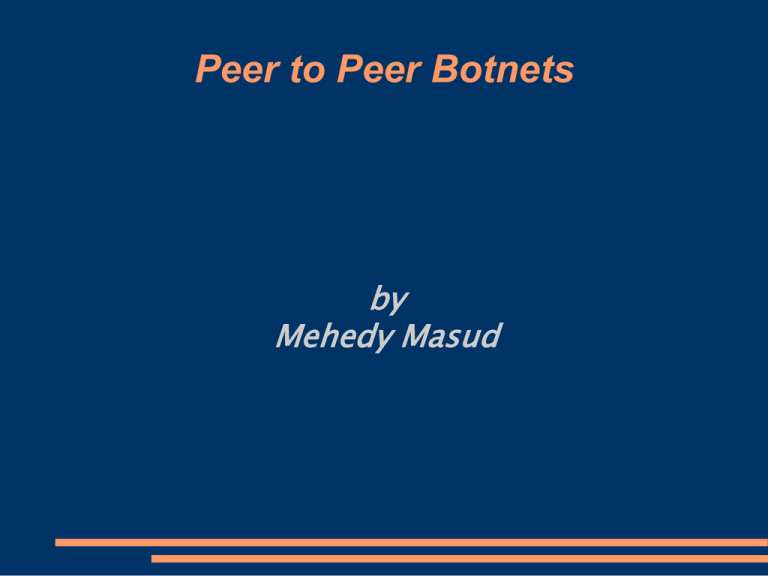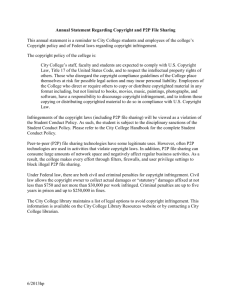Lecture26 - The University of Texas at Dallas
advertisement

Peer to Peer Botnets by Mehedy Masud Botnets ● ● ● ● ● ● ● Introduction History Taxonomy Overview Case studies New technique Detection and Prevention Taxonomy Peer2Peer Bots: Overview & Case Studies ● Jullian B Grizzard – ● Vikram Sharma, Chris Nunnery, and Brent ByungHoon Kang – ● John Hopkins North Carolina, Chappel Hill David Dagon – Georgia Institute of Technology HotBots - 2007 Peer2Peer BotNets: History ● Napster: earliest Peer2Peer protocol – – ● Gnutella – ● Not completely P2P Shutdown because found illegal Completely decentralized Recent Protocols – – Chord Kademila Botnet Goals ● All kinds of botnet have the same goals – – – ● ● ● Information dispersion Information harvesting Information processing Information dispersion – – Spam, phishing, DOS etc. Economic benefit – – Identity data, password, relationship data etc Direct economic benefit – Cracking passwords Information harvesting Information processing Case Study: Trojan.Peacomm ● ● ● ● Uses the Overnet p2p protocol Overnet implements a distributed hash table based on Kademila algorithm After infection, secondary injections are automatically downloaded from p2p net This enables hacker to arbitrarily upgrade, control, or command bots Experimental Setup ● Trojan.Peacomm was executed within a honeypot in UNCC HoneyNet Lab ● Honeypot was running VMWare virtual machine running windows XP ● Connections to the internet was controlled by a HoneyWall ● PerylEyez malware analysis tool was used to detect changes in the system ● Pcap logs were kept, speciment ran for two weeks Initial bot ● ● ● ● ● The executable is installed Connects to p2p and downloads secondary injection Distributed as a trojan horse email PerilEyez tool is used to Capture system state before and after infection (file system/open port/services) It adds system driver “wincomm32.sys” to the host – Driver is injected into windows process “services.exe” Initial bot (continued) – – ● ● Windows Firewall is disabled Ports opened: – – ● ● This service acts as a p2p client that downloads secondary injection Initial peer list saved in %system%\wincom.ini TCP 139, 12474 UDP 123, 137 etc. Initial Peer List is Hard-coded This could be a central point-of failure Communication Protocol ● Protocol Summary – – – – – ● Overnet, implementing Kademila 128-bit numeric space is used Values are mapped to numeric space with keys Key/value pairs are stored in the nearest pair, computed by XOR function List of nodes are kept for each bucket in the numeric space Steps – – – – – Connect to overnet Download secondary injection URL Decrypt secondary injection URL Download secondary injection Execute secondary injection Secondary Injection ● Types of secondary injection – – – – – ● ● ● Downloader and rootkit component SMTP spamming component Email address harvester Email propagation component DDoS tool All of these can be rooted from one injection Can periodically update itself by searching through the P2P net This provides the basic Command and Control functionality Searching the Download URL ● ● ● ● A search key is generated in the bot using an algorithm that Uses system date and a random number (0..31) So the botmaster needs to publish a new URL under 32 different keys on a particular day It searches for this key in its initial peer list If it is not found in a peer, the request is forwarded to other peers Searching the Download URL ● If a match is found, a result is returned: ● ● ● ● The “result” hash is used as as decryption key, paired with another key is hardcoded in bot Also, the response packet contains a single meta-tag named “id” The body of the tag contains the encrypted URL Index Poisoning ● ● ● ● ● P2P networks contain indexes corresponding to each content Index poisoning means adding bogus records to indexes For example, adding a fake ip/port corresponding to a file Trojan.peacomm has index poisoning capability Possible motive: slowing down infection or measuring number of bots Network Trace Analysis ● Number of Remote IPv4 Addresses Contacted Over Time for Duration of Infection Slowing down (saturation) Steep slope (initial connections) Start of infection Network Trace Analysis (Contd…) ● ● ● ● ● ● Network traces are parsed It is found that the bot searches for five keys. Key1 is the hash of its own IP – It periodically searches key1 to find the nearest peers Key2 and Key4 are never found Key3 and Key5 are found after small search Key3 is found in 6 seconds, key5 is found in 3 seconds Network Trace Analysis (Contd…) ● ● ● ● This indicates that “command latency” for P2P bots is low (but higher than Centralized) Number of unique hosts contacted directly: 4200 Total unique IPs found in overnet packets: 10,105 Same search requests appeared from another machine – Possibly infected by Trojan.peacomm Conclusion ● ● ● This paper describes a case study of Trojan.Peacomm – a p2p Describes how it propagates and contacts with C&C Analysis of network trace presented Detecting P2P Botnets ● Reinier Schoof & Ralph Koning – University of Amsterdam Appeared in a technical report. Feb 2007 ● Spreading – – ● File sharing over P2P network Uses popular filenames to entice download Command and Control – – – ● Overview Unlike IRC, bots do not wait for command Botmaster joins the network as a peer Passes command along its peers Protocols – – Phatbot uses WASTE protocol Nugache and Spamthru uses home-made protocols Experiments ● Two bots are analysed in a controlled environment – – ● Nugache Sinit Test environment consists of – – – Four computers Three running Windows XP One running FreeBSD. This runs softflowd to act as a software router for connecting three machines, collecting all netflows ● Sinit – – – – – – – – Bot analysis Trojan horse Uses P2P to spread itself Tries to reach other Sinit infected hosts by sending discovery packets to port 53 of random IPs Establishes connection when it receives a discovery response packet Two hosts exchange list of peers Connects to those peers Runs a web server to publish /kx.exe, which is the Sinit binary Random IP scan generates a lot of ICMP 3 (host unreachable) Bot analysis (Contd…) ● Nugache – – – – – – – – – Trojan horse Opens TCP port 8, connects to hard-coded list of peers Exchange peer list after connection Starts DDoS when commanded Command is encrypted/obfuscated Spreads over AIM Installs initial peer list in windows registry This list is updated dynamically Uses obfuscated communication channel Bot analysis (Contd…) ● PhatBot – – – – – – A cousin of AgoBot Uses WASTE protocol It is an encrypted Open-source P2P Network Bot finds other peers by using cache servers on Gnutella P2P network Looks for clients identified by GNUT, a gnutella client Has a list of processes to kill when it runs Consisting of antivirus and competing malware ● Open ports – – – – ● A specific port/range of ports must be opened Monitoring those ports may enable detection May result in false positive (when other applications use specific ports) or False negative (when normal ports are used for bot communication) Connection failures – ● Detection May result in a lot of ICMP 3 error Peer Discovery – – Static peer list may be central point of failure Random scan is very inefficient Conclusion P2P botnets pose significant threat to future internet community Although current P2P protocols used by the bots are inefficient, they are likely to be made efficient There are some detection techniques, but none of them are too reliable






